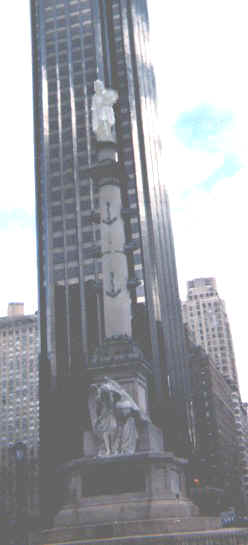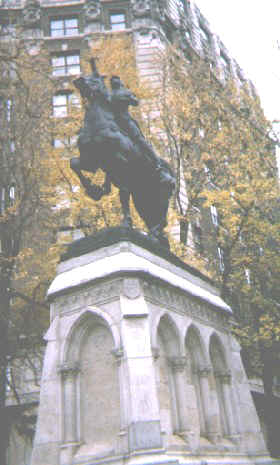Christine Delgado, Louise Marchena, & Maria Russo

Christopher Columbus
in Columbus Circle. |
CHRISTOPHER COLUMBUS
Christopher
Columbus was born in Genoa in 1451. Although an Italian, he won fame as a navigator in the
service of Spain.
He was born to a master weaver who also owned a wine shop. While working for his
father, Columbus began to follow the sea at a young age. He was required to go on
occasional coastal voyages to collect supplies of wool or wine.
As he grew older, his voyages became longer, until on one voyage he ended up penniless
in Portugal. This was the turning point of his life. Though not a professional seaman,
Columbus acquired during his Portuguese years comprehensive seagoing experience in
precisely those areas which would be useful for ocean exploration.
Columbus came up with a project he called Enterprise to the Indies, for
which he gained the financial support of Spain for an expedition not to "find a new
land", but to initiate trade with India and China.
Columbus sailed due West in the hope of reaching India, but what he
"discovered" instead were the Americas. In fact, although Columbus voyaged all
around the Carribean and landed on many islands, he never fully understood that he had
come upon a hitherto unknown (to most Europeans) continent.
Hs exploration to India may have failed, but Christopher Columbus made the initial
discovery from which the entire European exploration and settlement of the Americas began.
|
| JOAN OF ARC
Joan of Arc
was French peasant girl who was born in 1412. Her family were poor farmers who raised five
children, including Joan.
Joan was more religious than most girls of her village, and at the age of thirteen she
began to hear voices that told her to free the city of Orleans from the English who were
besieging it. The voices she heard were those of Saint Michael, Saint Catherine, and Saint
Margaret, who would guide her for the rest of her life.
In 1429 she persuaded Robert Baudricourt, captain of the nearby town of Vaucouleurs, to
provide her with a small military escort for a dangerous journey to take the dauphin to
Reims where he would be crowned king of France. Joan also convinced Charles VII of her
divine mission to help drive the English from France. In convincing Charles VII Joan was
granted a commanding role in a sizable force to lift the English siege, in which she
succeeded.
The English wanted possession of Joan for she had become an impediment to their
conquest of France. She was delivered to the Inquisition, where she was tried for heresy
and for not submitting to the authority of the church by dressing in men's clothes.
Joan was improperly held in a secular prison, guarded by male jailers, and denied
counsel. She conducted a heroic yet hopeless self-defense in the face of aggressive
questioning. She was sentenced to life in prison for her crimes.
While in jail, Joan continued to dress in men's clothes to protect herself from the
male jailers. She was eventually found to be a "relapsed heretic" and was burned
at the stake in Rouen's Old Market in front of a large crowd.
Although Joan of Arc died a dishonorable death, she was canonized in 1920 and the
charges against her were found null and invalid. Because of her courage and beliefs, Joan
of Arc is known to be one of the greatest women in history.
|

Joan of Arc
Riverside Park. |
[Picture missing]
Saint Patrick
Picture was taken of a statue of Saint Patrick located in Front of Old Saint
Patrick's Cathedral in lower Manhattan. |
SAINT PATRICK:
Saint Patrick,
is the patron saint and apostle of Ireland. He was born in western Britain in the fifth
century, to a Christian family of good standing. At the age of sixteen, Patrick was
captured and sold into slavery by Irish marauders. From then on he worked as a herdsman on
the slopes of Slemish in Ireland.
Patrick was had been indifferent to religion as a child, but during his captivity he
turned more and more to God. His life then came to be led by dreams and visions, which, he
claimed, were of divine inspiration.
After six years in Ireland, Patrick had a dream in which God told him that a ship
lay ready to take him home. Because of this dream, he escaped and after walking 200 miles,
he found a port with a ship ready to sail. After sailing for three days the ship found
land. With the crew nearly starving, Patrick began to pray for food. God once again
met his need and sent a herd of wild pigs across their path. Shortly after avoiding
starvation, Saint Patrick found himself reunited with his parents.
Patrick later entered the monastery at Lerins, where he received the tonsure. During
his days in the monastery, he continued to have visions. One very vivid vision was of him
returning to Ireland as a missionary. In 432AD Patrick was consecrated a missionary
bishop by St. Germanus of Auxerre. In Ireland he pursued his mission with sincerity and
vigor and was one of the most successful of the many fifth century ecclesiastics who
labored on the conversion of Ireland.
|
LINKS
REFERENCES
Bogart, Michele Helene, Public Sculpture and the Civic Ideal in New York City, 1890-
1930, (Chicago: University of Chicago Press, 1989)
Jacoby, Stephen M., Architectural Sculpture in New York City, (New York City:
Dover, 1975)
Reynolds, Donald M., Monuments and Masterpieces: History and Views of Public
Sculpture in New York City, (New York City: Thames and Hudson, 1997)
Jackson, Kenneth T., The Encyclopedia of New York City, (New Haven: Yale
University Press, 1995)
| Medieval
New York |
The Internet History Sourcebooks Project is located at the History Department of Fordham University, New York. The Internet
Medieval Sourcebook, and other medieval components of the project, are located at
the Fordham University Center
for Medieval Studies.The IHSP recognizes the contribution of Fordham University, the
Fordham University History Department, and the Fordham Center for Medieval Studies in
providing web space and server support for the project. The IHSP is a project independent of Fordham University. Although the IHSP seeks to follow all applicable copyright law, Fordham University is not
the institutional owner, and is not liable as the result of any legal action.
© Site Concept and Design: Paul Halsall created 26 Jan 1996: latest revision 12 April 2024 [CV]
|